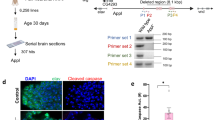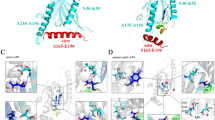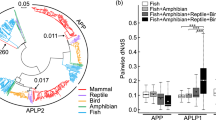Abstract
β-Amyloid precursor protein binding protein 1 (APP-BP1) was previously identified based on its binding to the carboxyl terminal of β-amyloid precursor protein. In this report, we have discovered that a mutation of dAPP-BP1 (Drosophila ortholog of APP-BP1) hinders tissue development, causes apoptosis in imaginal disc cells, and blocks the NEDD8 conjugation pathway. We show that dAPP-BP1 specifically binds the intracellular domain of APP-like protein (APPL). The dAPP-BP1 mutation partially suppresses the abnormal macrochaete phenotype of Appld, while overexpression of dAPP-BP1 causes abnormal macrochaetes. When APPL is overexpressed, the normal bristle pattern in the fly thorax is disturbed and apoptosis is induced in wing imaginal discs. APPL overexpression phenotypes are enhanced by reducing the level of dAPP-BP1. APPL overexpression is shown to inhibit the NEDD8 conjugation pathway. APPL-induced apoptosis is rescued by overexpression of dAPP-BP1. Our data suggest that APPL and dAPP-BP1 interact antagonistically during Drosophila development.
Similar content being viewed by others
Log in or create a free account to read this content
Gain free access to this article, as well as selected content from this journal and more on nature.com
or
Abbreviations
- AD:
-
Alzheimer's disease
- ap :
-
apterous
- APP:
-
β-amyloid precursor protein
- APP-BP1:
-
β-amyloid precursor protein binding protein 1
- APPL:
-
APP-like protein
- Ci:
-
cubitus interruptus
- Da :
-
daughterless
- ECD:
-
extracellular domain
- EST:
-
expressed sequence tag
- ICD:
-
intracellular domain
- RT-PCR:
-
polymerase chain reaction after reverse transcription of RNA
- SDS-PAGE:
-
sodium dodecyl sulfate polyacrylamide gel electrophoresis
- SCF complexes:
-
Roc1/Rbx1/Hrt1-Skp1-Cullin/Cdc53-F box complexes
- TUNEL:
-
terminal deoxynucleotidyl transferase mediated-biotinylated UTP nick end labeling
- UTR:
-
untranslated regions
References
Chow N, Korenberg JR, Chen X-N, Neve RL . APP-BP1, a novel protein that binds to the carboxyl-terminal region of the amyloid precursor protein. J Biol Chem 1996; 271: 11339–11346.
Hochstrasser M . Evolution and function of ubiquitin-like protein-conjugation systems. Nat Cell Biol 2000; 2: E153–E157.
Chen Y, McPhie DL, Hirschberg J, Neve RL . The amyloid precursor protein-binding protein APP-BP1 drives the cell cycle through the S–M checkpoint and causes apoptosis in neurons. J Biol Chem 2000; 275: 8829–8835.
Chen Y, Liu W, McPhie DL, Hassinger L, Neve RL . APP-BP1 mediates APP-induced apoptosis and DNA synthesis and is increased in Alzheimer's disease brain. J Cell Biol 2003; 163: 27–33.
Pan ZQ, Kentsis A, Dias DC, Yamoah K, Wu K . Nedd8 on cullin: building an expressway to protein destruction. Oncogene 2004; 23: 1985–1997.
Xirodimas DP, Saville MK, Bourdon JC, Hay RT, Lane DP . Mdm2-mediated NEDD8 conjugation of p53 inhibits its transcriptional activity. Cell 2004; 118: 83–97.
Deshaies RJ . SCF and Cullin/Ring H2-based ubiquitin ligases. Annu Rev Cell Dev Biol 1999; 15: 435–467.
Karin M, Ben-Neriah Y . Phosphorylation meets ubiquitination: the control of NF-[kappa]B activity. Annu Rev Immunol 2000; 18: 621–663.
Kondo K, Kaelin JWG . The von Hippel–Lindau tumor suppressor gene. Exp Cell Res 2001; 264: 117–125.
Ohh M, Kim WY, Moslehi JJ, Chen Y, Chau V, Read MA et al. An intact NEDD8 pathway is required for Cullin-dependent ubiquitylation in mammalian cells. EMBO Rep 2002; 3: 177–182.
Liu J, Furukawa M, Matsumoto T, Xiong Y . NEDD8 modification of CUL1 dissociates p120CAND1, an inhibitor of CUL1-SKP1 binding and SCF ligases. Mol Cell 2002; 10: 1511–1518.
Wu K, Chen A, Tan P, Pan ZQ . The Nedd8-conjugated ROC1-CUL1 core ubiquitin ligase utilizes Nedd8 charged surface residues for efficient polyubiquitin chain assembly catalyzed by Cdc34. J Biol Chem 2002; 277: 516–527.
Ou CY, Lin YF, Chen YJ, Chien CT . Distinct protein degradation mechanisms mediated by Cul1 and Cul3 controlling Ci stability in Drosophila eye development. Genes Dev 2002; 16: 2403–2414.
Mori F, Nishie M, Piao YS, Kito K, Kamitani T, Takahashi H et al. Accumulation of NEDD8 in neuronal and glial inclusions of neurodegenerative disorders. Neuropathol Appl Neurobiol 2005; 31: 53–61.
Rosen DR, Martin-Morris L, Luo LQ, White K . A Drosophila gene encoding a protein resembling the human beta-amyloid protein precursor. Proc Natl Acad Sci USA 1989; 86: 2478–2482.
Kang J, Lemaire HG, Unterbeck A, Salbaum JM, Masters CL, Grzeschik KH et al. The precursor of Alzheimer's disease amyloid A4 protein resembles a cell-surface receptor. Nature 1987; 325: 733–736.
Luo LQ, Martin-Morris LE, White K . Identification, secretion, and neural expression of APPL, a Drosophila protein similar to human amyloid protein precursor. J Neurosci 1990; 10: 3849–3861.
Sisodia SS . Cellular and molecular genetic approaches in Alzheimer's disease. Neurobiol Aging 1994; 15: S135–S137.
Slunt HH, Thinakaran G, Von Koch C, Lo AC, Tanzi RE, Sisodia SS . Expression of a ubiquitous, cross-reactive homologue of the mouse beta-amyloid precursor protein (APP). J Biol Chem 1994; 269: 2637–2644.
Luo L, Tully T, White K . Human amyloid precursor protein ameliorates behavioral deficit of flies deleted for Appl gene. Neuron 1992; 9: 595–605.
Torroja L, Luo L, White K . APPL, the Drosophila member of the APP-family, exhibits differential trafficking and processing in CNS neurons. J Neurosci 1996; 16: 4638–4650.
Torroja L, Chu H, Kotovsky I, White K . Neuronal over-expression of APPL, the Drosophila homologue of the amyloid precursor protein (APP), disrupts axonal transport. Curr Biol 1999a; 9: 489–493.
Torroja L, Packard M, Gorczyca M, White K, Budnik V . The Drosophila beta-amyloid precursor protein homolog promotes synapse differentiation at the neuromuscular junction. J Neurosci 1999b; 15: 7793–7803.
Gunawardena S, Goldstein LSB . Disruption of axonal transport and neuronal viability by amyloid precursor protein mutations in Drosophila. Neuron 2001; 32: 389–401.
Tschape JA, Hammerschmied C, Muhlig-Versen M, Athenstaedt K, Daum G, Kretzschmar D . The neurodegeneration mutant lochrig interferes with cholesterol homeostasis and Appl processing. EMBO J 2002; 21: 6367–6376.
Li Y, Liu T, Peng Y, Yuan C, Guo A . Specific functions of Drosophila amyloid precursor-like protein in the development of nervous system and nonneural tissues. J Neurobiol 2004; 61: 343–358.
King GD, Scott Turner R . Adaptor protein interactions: modulators of amyloid precursor protein metabolism and Alzheimer's disease risk? Exp Neurol 2004; 185: 208–219.
Merdes G, Soba P, Loewer A, Bilic MV, Beyreuther K, Paro R . Interference of human and Drosophila APP and APP-like proteins with PNS development in Drosophila. EMBO J 2004; 23: 4082–4095.
Hériché JK, Ang D, Bier E, O'Farrell PH . Involvement of an SCFSlmb complex in timely elimination of E2F upon initiation of DNA replication in Drosophila. BMC Genet 2003; 4: 9–21.
Tateishi K, Omata M, Tanaka K, Chiba T . The NEDD8 system is essential for cell cycle progression and morphogenetic pathway in mice. J Cell Biol 2001; 155: 571–579.
Bech-Otschir D, Seeger M, Dubiel W . The COP9 signalosome: at the interface between signal transduction and ubiquitin-dependent proteolysis. J Cell Sci 2002; 115: 467–473.
Cope GA, Deshaies RJ . COP9 signalosome: a multifunctional regulator of SCF and other cullin-based ubiquitin ligases. Cell 2003; 114: 663–671.
Feng S, Shen Y, Sullivan JA, Rubio V, Xiong Y, Sun TP et al. Arabidopsis CAND1, an unmodified CUL1-interacting protein, is involved in multiple developmental pathways controlled by ubiquitin/proteasome-mediated protein degradation. Plant Cell 2004; 16: 1870–1882.
Zheng J, Yang X, Harrell JM, Ryzhikov S, Shim EH, Lykke-Andersen K et al. CAND1 binds to unneddylated CUL1 and regulates the formation of SCF ubiquitin E3 ligase complex. Mol Cell 2002; 10: 1519–1526.
Ayyub C, Sen A, Gonsalves F, Badrinath K, Bhandari P, Shashidhara LS et al. Cullin-5 plays multiple roles in cell fate specification and synapse formation during Drosophila development. Dev Dyn 2005; 232: 865–875.
Leyssen M, Ayaz D, Hebert SS, Reeve S, De Strooper B, Hassan BA . Amyloid precursor protein promotes post-developmental neurite arborization in the Drosophila brain. EMBO J 2005; 24: 2944–2955.
Zhu S, Perez R, Pan M, Lee T . Requirement of Cul3 for axonal arborization and dendritic elaboration in Drosophila mushroom body neurons. J Neurosci 2005; 25: 4189–4197.
Motzny CK, Holmgren R . The Drosophila cubitus interruptus protein and its role in the wingless and hedgehog signal transduction pathways. Mech Dev 1995; 1: 137–150.
Spradling A, Rubin GM . Genetic transformation of Drosophila with transposable element vectors. Science 1982; 4570: 348–353.
Capdevila J, Guerrero I . Targeted expression of the signaling molecule decapentaplegic induces pattern duplications and growth alterations in Drosophila wings. EMBO J 1994; 13: 4459–4468.
Acknowledgements
We thank Daria Hekmat-Scafe, Jeff Tan, Ed Glasscock, Shefa Gordon, and Juan Song for discussion and contributions to this work. The research was supported by a grant (M103KV010002 04K2201 00230) from Brain Research Center of the 21st Century Frontier Research Program funded by the Ministry of Science and Technology, the Republic of Korea to JY, and grants from the NIH and the Epilepsy Foundation to MT.
Author information
Authors and Affiliations
Corresponding author
Additional information
Edited by J Abrams
Supplementary Information accompanies the paper on Cell Death and Differentiation website (http://www.nature.com/cdd)
Supplementary information
Rights and permissions
About this article
Cite this article
Kim, HJ., Kim, SH., Shim, SO. et al. Drosophila homolog of APP-BP1 (dAPP-BP1) interacts antagonistically with APPL during Drosophila development. Cell Death Differ 14, 103–115 (2007). https://doi.org/10.1038/sj.cdd.4401935
Received:
Revised:
Accepted:
Published:
Issue date:
DOI: https://doi.org/10.1038/sj.cdd.4401935
Keywords
This article is cited by
-
APLP1 promotes dFoxO-dependent cell death in Drosophila
Apoptosis (2015)
-
Analysis of amyloid precursor protein function in Drosophila melanogaster
Experimental Brain Research (2012)



